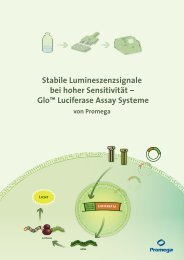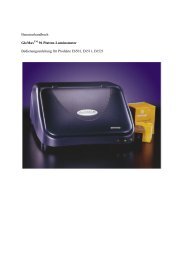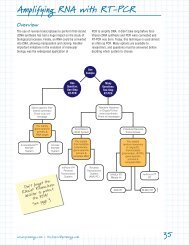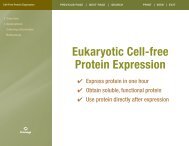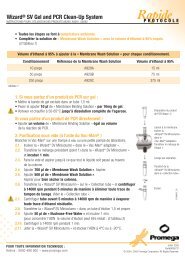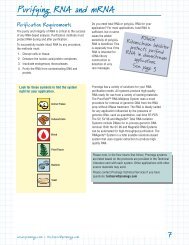DNA Analysis Notebook chapter: Cloning PCR DNA - Promega
DNA Analysis Notebook chapter: Cloning PCR DNA - Promega
DNA Analysis Notebook chapter: Cloning PCR DNA - Promega
You also want an ePaper? Increase the reach of your titles
YUMPU automatically turns print PDFs into web optimized ePapers that Google loves.
40<br />
<strong>Cloning</strong> <strong>PCR</strong> <strong>DNA</strong><br />
<strong>PCR</strong> <strong>Cloning</strong> Techniques (continued)<br />
What <strong>PCR</strong> <strong>Cloning</strong> Controls Can Do For You<br />
Each <strong>Promega</strong> <strong>PCR</strong> cloning system is provided with a<br />
Control Insert. The ligation and subsequent transformation<br />
of the Control Insert can give you a lot of information<br />
about your ligation and transformation reactions.<br />
The total number of blue colonies in Control Insert and<br />
no-insert controls should be approximately equal. The<br />
negative control may have some white colonies.<br />
Typical <strong>PCR</strong> <strong>Cloning</strong> Results Using pGEM ® -T<br />
Easy Vector and JM109 Competent Cells<br />
(1.5 × 10 8 cfu/ng <strong>DNA</strong>).<br />
Efficiency % White<br />
(cfu/ng <strong>DNA</strong>) Colonies<br />
Control Insert 1,110 92%<br />
Control Insert 1,125 92%<br />
No insert 92 0%<br />
No insert 109 0%<br />
Ligations performed at room temperature for 1 hour.<br />
Bacterial Plates for Blue/White Selection<br />
LB medium (per liter)<br />
10g Bacto ® -tryptone<br />
5g Bacto ® -yeast extract<br />
5g NaCl<br />
Adjust pH to 7.0 with NaOH.<br />
Ampicillin Stock Solution<br />
Dissolve at 50mg/ml in water. Filter sterilize. Store in<br />
aliquots at –20°C<br />
IPTG stock solution (0.1M)<br />
1.2g IPTG (Cat.# V3951)<br />
Add water to 50ml final volume. Filter-sterilize and<br />
store at 4°C.<br />
X-Gal (2ml)<br />
100mg X-Gal (Cat.# V3941)<br />
Dissolve in 2ml N,N′-dimethyl-formamide. Cover with<br />
aluminum foil and store at –20°C.<br />
LB plates with ampicillin/IPTG/X-Gal<br />
Add 15g agar to 1 liter of LB medium. Autoclave.<br />
Allow the medium to cool to 50°C before adding<br />
ampicillin to a final concentration of 100µg/ml, then<br />
supplement with 0.5mM IPTG and 80µg/ml X-Gal and<br />
pour the plates. Pour 30–35ml of medium into 85mm<br />
petri dishes. Let the agar harden. Store at 4°C for up<br />
to 1 month or at room temperature for up to 1 week.<br />
Interpreting Results<br />
Results with the experimental insert look like those<br />
with the Control Insert in terms of efficiency and %<br />
white colonies.<br />
Successful experiment. Greater than 80% of the white<br />
colonies should contain inserts.<br />
Results with the experimental insert and Control<br />
Insert look like the negative control.<br />
Ligation has failed. Avoid multiple freeze/thaws of the<br />
ligation buffer. Ligase buffer contains ATP and could<br />
be damaged by freeze-thaws. You may need to aliquot<br />
the ligase buffer into useful portions for your<br />
experimental needs.<br />
Few/No colonies with experimental insert, Control<br />
Insert or negative control.<br />
Transformation has failed. Reassess the competent<br />
cells with an intact, supercoiled plasmid and<br />
determine the transformation efficiency. Use cells<br />
>1 × 108cfu/µg to insure >100 colonies from the<br />
Control Insert ligation.<br />
Experimental insert gives more blue colonies than<br />
the Control Insert or negative control and less white<br />
colonies than the Control Insert.<br />
In-frame insertion with no interruption of the<br />
α-fragment. Although the pGEM-T Vector Control<br />
Insert will produce recombinants that generate white<br />
colonies, the insertion of other <strong>DNA</strong> fragments into the<br />
lacZ coding sequence may not result in white colonies<br />
unless the fragments disrupt the lacZ reading frame.<br />
Although this tends to occur most frequently with <strong>PCR</strong><br />
products of 500bp or less, inserts of up to 2kb have<br />
been reported to result in blue colonies. Moreover,<br />
some insert <strong>DNA</strong>s can also give pale blue colonies or<br />
“bull’s eye” colonies that have a blue center and a<br />
white perimeter. In one case, we found that a 1.8kb<br />
insert produced white colonies when oriented in one<br />
direction and bull’s eye colonies when oriented in the<br />
opposite direction (1).<br />
1. Knoche, K. and Kephart, D. (1999) <strong>Cloning</strong> blunt-end Pfu <strong>DNA</strong><br />
polymerase-generated <strong>PCR</strong> fragments into pGEM-T Vector Systems.<br />
<strong>Promega</strong> Notes 71, 10–13.<br />
<strong>Promega</strong> <strong>DNA</strong> <strong>Analysis</strong> <strong>Notebook</strong>





